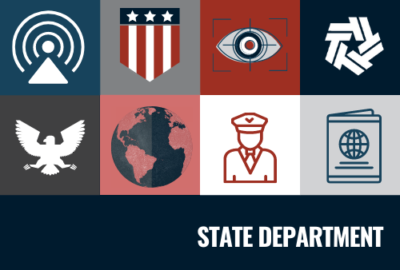How the State Department deals with one of the worst legacies of ground wars
Imagine getting injured or killed by a piece of ordnance months or years after a war has ended. Yet this occurs all-too-frequently around the world thanks to...
Best listening experience is on Chrome, Firefox or Safari. Subscribe to Federal Drive’s daily audio interviews on Apple Podcasts or PodcastOne.
Imagine getting injured or killed by a piece of ordnance months or years after a war has ended. Yet this occurs all-too-frequently around the world thanks to leftover land mines and unexploded shells and bombs. For many years, the State Department’s Office of Weapons Removal and Abatement has worked with international partners to reduce this problem. Joining the Federal Drive with Tom Temin with a progress report, program director Karen Chandler.
Interview transcript:
Tom Temin: Ms. Chandler, good to have you on.
Karen Chandler: Thank you so much.
Tom Temin: And give us the background here. This goes back to I guess landmines are leftover from World War II even in some parts of the world.
Karen Chandler: Yes, absolutely. There are still leftover unexploded ordinance or UXO, as we call it in the Pacific islands that have been left over since World War II, Southeast Asia also has quite a lot of unexploded ordnance and landmines leftover from the Vietnam War. So this is a long standing problem in many parts of the world. But the U.S. has been the largest supporter of conventional weapons destruction and demining programs since 1993. And we’ve provided over $4.2 billion in more than 100 countries since that time.
Tom Temin: And this is really something that happens on every continent, to some degree fair to say?
Karen Chandler: Yes, absolutely.
Tom Temin: And do we know the extent of how many people for example, are injured or killed every year by these items that are left around?
Karen Chandler: Yes, there’s a report that’s put out every year called the landmine monitor. And I believe that the most recent statistics from 2021 are that approximately 7,000 people had been injured or killed by landmines around the world, just in this past year. And the really heartbreaking part of that is that over 50% of those known casualties are innocent children.
Tom Temin: Wow. Well tell us more about the program for removal. That is to say, you fund NGOs is it or who does the work? And how do they relate to the State Department?
Karen Chandler: So we work with a whole host of international NGOs, nongovernmental organizations, and also private sector entities and members of foreign governments, as well as the Department of Defense and the U.S. Agency for International Development and other international organizations. So we fund them to the tune of about $265 million. In the last year, we worked in 62 countries across the Department of State defense and USAID with our implementing partners, we provide them with the funding, and the policy priorities and program management. And then they actually do the work in the field of removing these deadly pieces of unexploded ordnance and landmines.
Tom Temin: And what kinds of organizations specifically and what kinds of people actually do this work?
Karen Chandler: So these are highly technical experts. Some of the most well known organizations that we work with are the HALO Trust, which is a U.K. entity. The Mines Advisory Group or MAG, also based in the U.K. is a very strong partner of ours. So those are international nongovernmental organizations that work on this. But there are also dozens upon dozens of smaller NGOs that are actually strictly limited to the host countries that we work with. For example, I recently met with a group in Colombia, that is the first Colombian agency certified for demining there.
Tom Temin: So in the case of Colombia, I’m guessing it was elements of Colombian society that didn’t like other elements of Colombian society that were sowing the soil with mines?
Karen Chandler: So the landmines that are in Colombia are the result of the long running civil war that happened there between the FARC and the Government of Colombia.
Tom Temin: And do you ever get cooperation from the people that might have laid the mines or left the ordinance behind? Maybe because it’s yours after hostilities, and everybody’s made up? And can they give you information from their records as to where to go look?
Karen Chandler: You know, in terms of whether or not they give us information on where to go look, it’s hard for me to answer that question specifically. But certainly, we have excellent cooperation from the host government. And sometimes these are host governments that previously were involved in the hostilities.
Tom Temin: Got it. We’re speaking with Karen Chandler, she’s director of the State Department’s Office of Weapons and Removal Abatement, part of the Bureau of Political Military Affairs. And what about technology? Has that evolved in recent years such that it’s easier to detect these items, and maybe also to defuse them or blow them up harmlessly?
Karen Chandler: Yes. So there’s actually quite a lot of technologies that come into play and one of the ways that people map the area that has been contaminated and needs to be removed is through old fashioned reporting. We talk to people on the ground and find out exactly where the areas of known contamination are on their land. But there’s also more highly technical methods that they can send in. In Iraq and Syria, the contractor that we worked with, sent in some robots to go in and discover some of the contaminations, specifically for improvised explosive devices, because those are a little bit different to deal with than traditional landmines. There’s also mine detection dogs that have been used very successfully in many parts of the world where the dogs are able to sniff out landmines and then alert their handlers. So their handlers know to go in with other types of technical equipment to remove the minds. Dogs, I should add, are not injured in this process.
Tom Temin: You answered my next question. And removal does that usually mean just blowing it up right there remotely or from a distance or taking it out?
Karen Chandler: It really depends on the type of explosive device that’s in the ground. For UXO for example, for unexploded ordnance, then a lot of times you’re talking about sometimes very large bombs that have to be very carefully removed from the ground and taken to another place to be detonated. For other types of explosive devices, they may be able to actually dismantle those explosive devices in place. So it really depends on what type of explosive hazard is being faced in that area.
Tom Temin: And under your program, there is also remediation for people that might have been injured by these devices.
Karen Chandler: Yes, there’s a program that is actually run by the U.S. Agency for International Development called the Leahy War Victims Fund, which is one of the legacies of Sen. Leahy (D-Vt.). And this program will actually provide some amount of medical rehabilitation and prosthetic limbs and training to people as well so that they can begin to live with their injuries and have a productive life.
Tom Temin: And looking at the brutal hostilities happening now in Ukraine perpetrated by Russia, is it possible to start beginning to assemble maps, let’s say, location indicators of where unexploded ordnance might have to be removed in the future. So that maybe when hostilities are over, you can get a leg up on them, so to speak.
Karen Chandler: Yes, I’m glad that you mentioned Ukraine because it’s just a tremendous tragedy that is continuing to unfold there. And unfortunately, Putin’s premeditated, unprovoked and unjustified full scale invasion has already undone our earlier progress while exposing exponentially more Ukrainian civilians to the threat of these explosive remnants of war.
The Russian Federation’s bombing and shelling of civilian apartment blocks, grocery stores, hospitals, schools and power plants is making the situation truly catastrophic. And the press is reporting dud rates of between 30% and 60% for Russian munitions. So these indiscriminate attacks by Russia will continue to pose a dire threat to all Ukrainians for years to come. Ukrainian officials estimate that up to 80,000 square kilometers may be contaminated by landmines, unexploded ordnance and other explosive remnants of war. And this is going to be especially dangerous as displaced people begin returning home and large scale relief and recovery efforts get away. So we are already funding digital explosive ordnance risk education campaigns. These have already provided life saving information to more than 18 million people in Ukraine since Russia’s Feb. 24 full scale invasion, the United States will continue to stand by the people of Ukraine and look for new opportunities to protect them from landmines and explosive remnants of war as the conditions on the ground continue to evolve.
Tom Temin: And just a technical detail. If something is a dud, that doesn’t mean it’s not dangerous, it just means the fuse didn’t work.
Karen Chandler: That’s correct.
Tom Temin: And you yourself have personally visited spots around the world. So this is personal in some sense for you, isn’t it?
Karen Chandler: Yes, I did serve in Afghanistan on two different occasions and the explosive remnants of war and IED problem there as well as the landmine problem is a continuing issue in Afghanistan as well.
Tom Temin: Well, we’re glad you’re on the job. Karen Chandler is director of the State Department’s Office of Weapons Removal and Abatement, part of the Bureau of Political Military Affairs. Thanks so much for joining me.
Karen Chandler: Thank you so much for having me.
Copyright © 2025 Federal News Network. All rights reserved. This website is not intended for users located within the European Economic Area.
Tom Temin is host of the Federal Drive and has been providing insight on federal technology and management issues for more than 30 years.
Follow @tteminWFED






